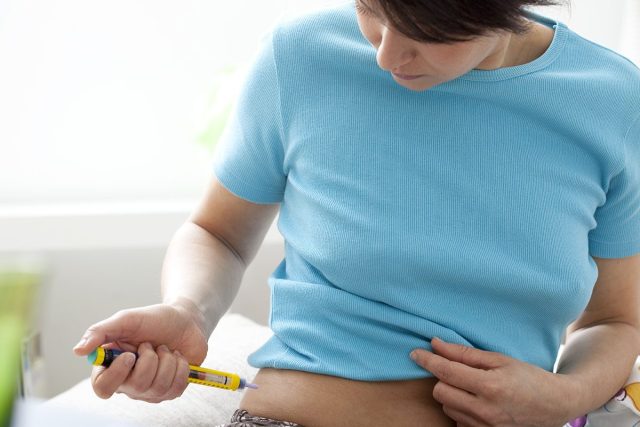Agencies-Gaza post
1 signal means you have Diabetes
Diabetes is a major health issue that affects over 37 million Americans and according to the Centers for Disease Control and Prevention, 1 in 5 people don’t realize they are diabetic. The CDC also states, “Diabetes and diabetes-related health complications can be serious and costly. The seventh leading cause of death in the United States, diabetes costs a total estimated $327 billion in medical costs and lost work and wages. In fact, people with diagnosed diabetes have more than twice the average medical costs that people without diabetes have.” Eat This, Not That! Health spoke with Dr. Katie Hill, MD, Chief Medical Officer at Nudj Health who explained everything to know about diabetes and signs that indicate you could have it.
1 What People Should Know About Diabetes

Dr. Hill says, “Diabetes is defined as a defect in metabolism causing elevated blood glucose levels for prolonged periods of time. Each time we eat, the digestive process begins in the mouth with saliva and mechanical chewing to break food into smaller pieces. Digestion continues in the stomach and into the small and large intestines with many other organs contributing as well. During this process, food is broken into its component parts such as glucose, proteins, and fats and they all get absorbed into the bloodstream. As glucose hits the blood, it triggers the release of a hormone called insulin from the pancreas. The insulin allows glucose to leave the blood vessels and enter cells so it can enter the Krebs cycle and get turned into ATP, the cellular energy source. Excess glucose is stored in the liver as glycogen and after that in fat cells as fat.”
2 Type 1 Diabetes Versus Type 2 Diabetes

Dr. Hill states, “There are two kinds of diabetes. Type 1 diabetes typically develops during childhood but can occur throughout adulthood as well. It is caused by the destruction of the islet cells in the pancreas that are responsible for insulin production. Type 2 diabetes is caused by increasing pancreatic insulin resistance. Chronically high levels of blood glucose burn out the glucose-sensing and glucose-producing machinery in the pancreas over time. Type 1 diabetes occurs overnight, is likely an auto-immune mediated process, and is irreversible though there are several exciting new potential treatments currently in development. Type 2 diabetes develops over time and is more likely to be caught early in the disease process. It’s curable with lifestyle changes such as weight loss, exercise, and dietary modification. Either type of Diabetes is diagnosed by findings of fasting blood glucose of greater than or equal to 126mg/dL on two separate occasions, or by finding a non-fasting blood glucose level of 200mg/dL on two separate occasions, or a glucose level greater than 200mg/dL with evidence of severely impaired metabolic blood work or related symptoms.”
3 Signs You Have Diabetes

According to the Centers for Disease Control and Prevention, “If you have any of the following diabetes symptoms, see your doctor about getting your blood sugar tested:
- Urinate (pee) a lot, often at night
- Are very thirsty
- Lose weight without trying
- Are very hungry
- Have blurry vision
- Have numb or tingling hands or feet
- Feel very tired
- Have very dry skin
- Have sores that heal slowly
- Have more infections than usual”
4 Signs You Have Serious Diabetes

Dr. Hill explains, “A diabetic crisis or emergency is life-threatening and is more likely to occur in Type I diabetes. Individuals present with blood glucose levels above 200mg/dL and have severe metabolic abnormalities and symptoms of starvation. It’s usually an emergency because people delay seeking help until they feel extremely ill and multiple organ systems have been affected. The high blood glucose spills into the urine, causing high urine output and dehydration. Prior to modern laboratory tests, one way to diagnose diabetes was to taste urine to detect glucose. Individuals are thirsty all the time despite drinking constantly.
Despite the high glucose levels in the blood, cells are unable to absorb the glucose because of the lack of insulin. Cells begin to starve and switch to alternative energy sources such as ketone bodies that are produced when fat and proteins are used to power the Krebs Cycle. Cellular starvation sends hunger signals to the brain and people feel hungry all the time but still have significant weight loss. In particularly severe cases, cells have been using only ketone bodies as fuel for so long that they have a severe presentation called diabetic ketoacidosis, or DKA.
Dehydration has become so severe that mucous membranes are dry and skin gets floppy and empty from low water volumes in the body. This also leads to an elevated heart rate, low blood pressure, and rapid, very deep breathing called Kussmaul’s respirations. Breath smells like acetone.
Often people with DKA have nausea, vomiting, abdominal pain, and sometimes a severe stricture of the intestines called an ileus that doesn’t allow any food or fluid through. Individuals diagnosed with DKA will experience severe sleepiness, difficulty thinking, and sometimes slip into a coma. Death can occur in about 1% of individuals diagnosed with DKA even at the most sophisticated hospitals.”
5 How Diabetes Can Become Life-Threatening

“Glucose is the body’s preferred fuel that is used to create the cellular energy source ATP, which is produced in the Krebs Cycle,” says Dr. Hill. “When cells cannot access glucose, they’re forced to start using ketone bodies that come from using fat and protein sources of energy.
Even though the body is capable of surviving in a mildly ketotic state for weeks or months, it isn’t equipped to handle a complete lack of glucose for longer than several days. Severely elevated blood glucose triggers a cascade of problems in many organ systems that all feedback on each other to worsen the situation. It’s usually an emergency because people delay seeking help until they feel extremely ill. The high blood glucose spills into the urine, causing high urine output and dehydration. Individuals experience excessive thirst even when drinking water constantly. Despite the high glucose levels in the blood, cells are unable to absorb the glucose because of the lack of insulin. The cellular starvation sends hunger signals to the brain and people feel hungry and eat excessively but still have significant weight loss. In particularly severe cases, cells have been using only ketone bodies as fuel for so long that they have a severe presentation called diabetic ketoacidosis, or DKA.
Dehydration has become so severe that mucous membranes are dry and skin gets floppy and empty from low water volumes in the body. This also leads to an elevated heart rate, low blood pressure, and rapid, very deep breathing called Kussmaul’s respirations. Breath smells like acetone. Often people with DKA have nausea, vomiting, abdominal pain, and sometimes a severe stricture of the intestines called an ileus that doesn’t allow any food or fluid through. Individuals diagnosed with DKA will experience severe sleepiness, difficulty thinking, and sometimes slip into a coma. Death can occur in about 1% of individuals diagnosed with DKA even at the most sophisticated hospitals.”
6 How Diabetes Can Go Undetected

Dr. Hill shares, “Type 2 diabetes develops slowly over time and in the beginning, the only sign is an elevated blood glucose level, which is only ordered during a medical exam. If people delay or avoid getting routine physical examinations, there is no way of knowing they have diabetes until symptoms appear and the disease is severe. Type 1 diabetes typically occurs suddenly and symptoms begin more quickly. It’s possible, however, to have no symptoms if it’s early in the disease process and if your body is particularly resilient. However, people will always develop symptoms within a matter of days to weeks.”
7 How Diabetes Can Affect Your Overall Health

Dr. Hill says, “Untreated diabetes affects almost every organ system in the body. Glucose blood levels are controlled very tightly by the body as it is both the preferred energy source as well as a source of potential inflammation and damage. Chronically high blood glucose damages the delicate epithelial lining of blood vessels and triggers an inflammatory repair process throughout the body.
Over the course of time, repeated injuries to blood vessels and a chronic state of inflammation can cause irreversible damage. Blood vessels thicken, develop plaques, and clots and increase the risk for high blood pressure, heart attacks, heart failure, and strokes. Eyesight is damaged because of hemorrhages in the retina. The kidneys are damaged with increased protein deposits that over time can lead to kidney failure.
Nerves are damaged starting with the nerve tips farthest from the brain that affect both feet and toes in a symmetrical fashion. Sometimes the nerve damage is less obvious, with nerves controlling the digestive tract or bladder accumulating damage with symptoms of early satiety, poor digestion, and poor bladder control. Nerve damage to the penis and male reproductive tract causes erectile damage.
The body’s immune system is damaged and is less able to prevent and fight infection-causing risks of bacterial infections of bones requiring amputation and yeast infections of the skin and mucous membranes. Skin becomes thick and discolored with dark purple or black spots. Overall, having diabetes increases the risk of death to that of someone who has already survived one heart attack.”
8 How to Help Manage Diabetes

Dr. Hill states, “Type 1 diabetes is managed with insulin given through daily injections or through a machine that automatically injects insulin multiple times a day. Type 2 diabetes is curable with weight loss, dietary changes such as switching to a whole-food, plant-based diet, and increased exercise. Type 2 diabetes can also be managed with medications such as metformin, sulphonylureas such as Glipizide, thiazolidinediones such as Rosilitazone, and many others. Many of the medications have side effects that are difficult to tolerate.”
Source: here






















